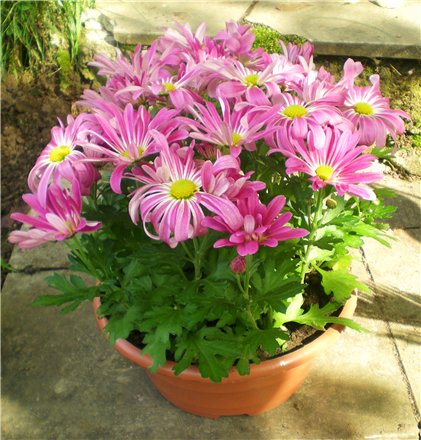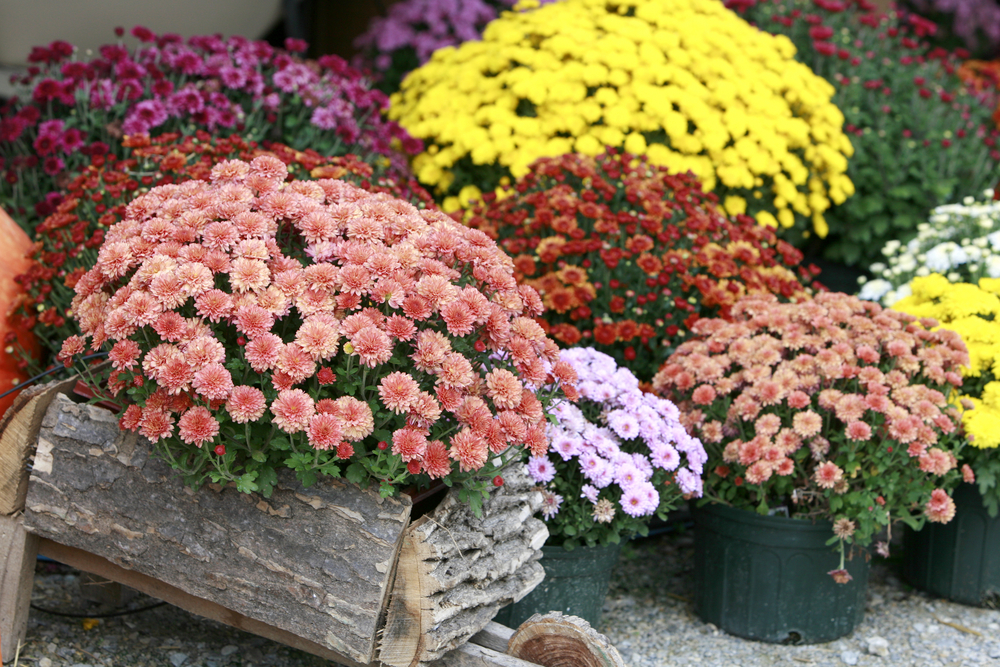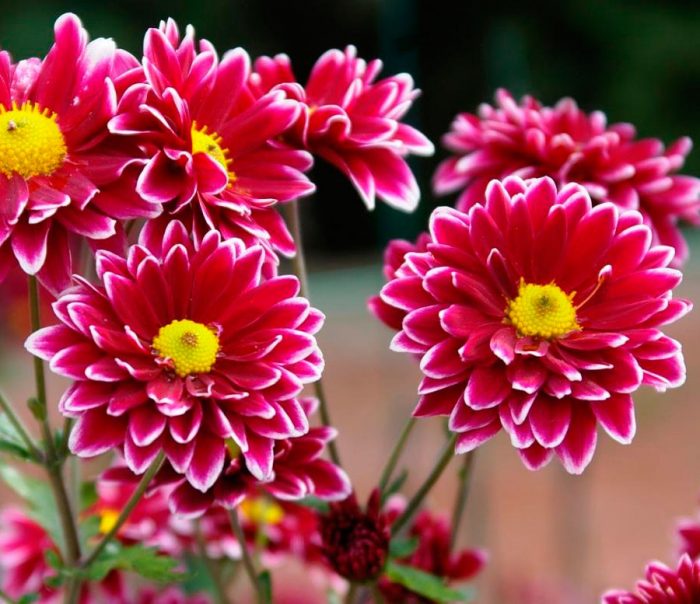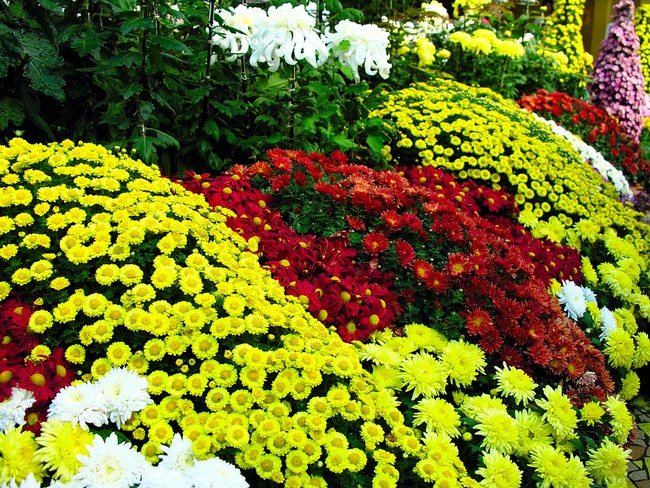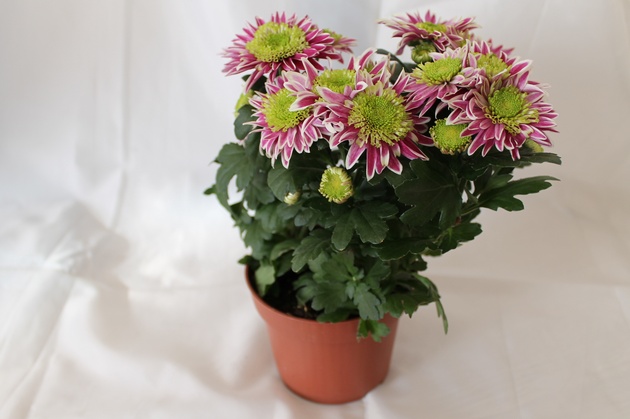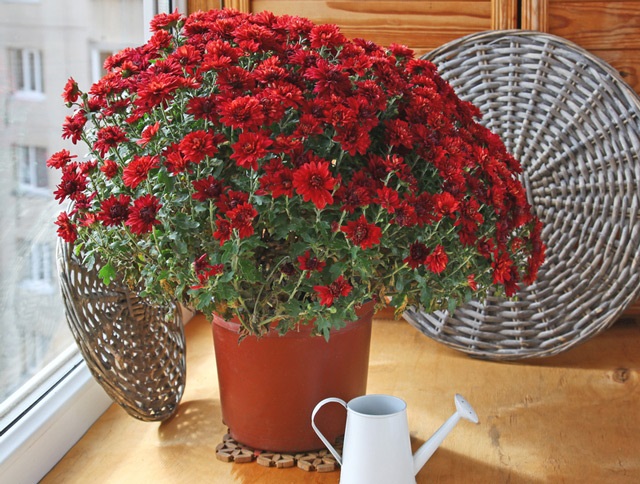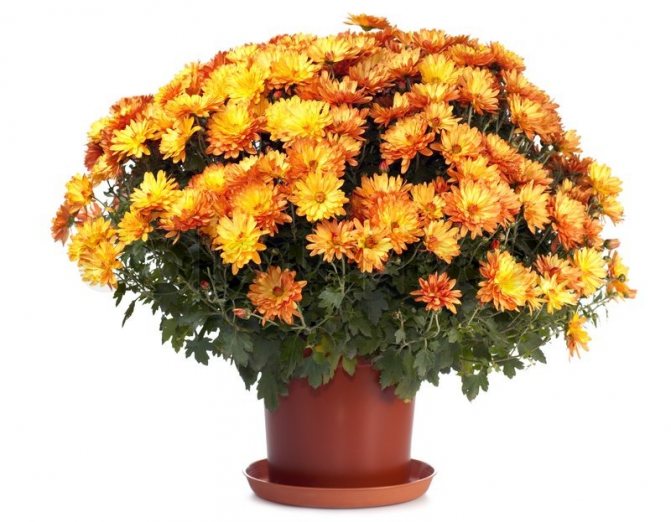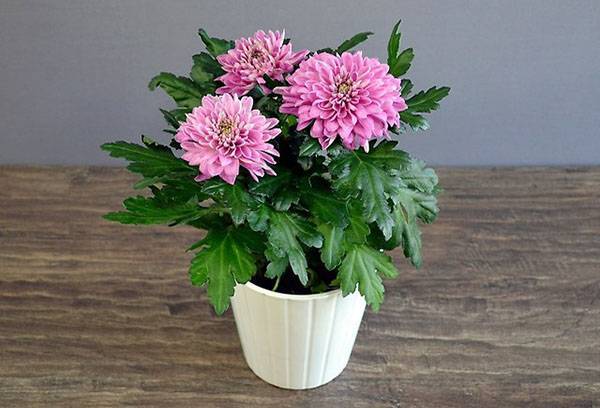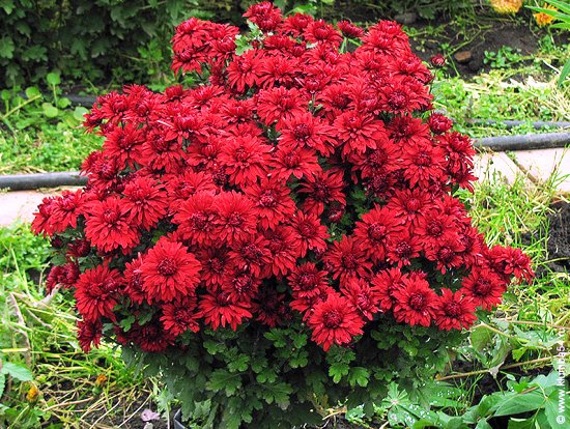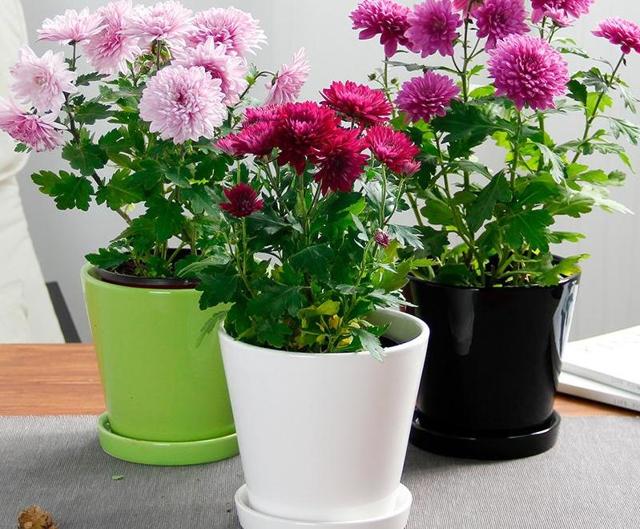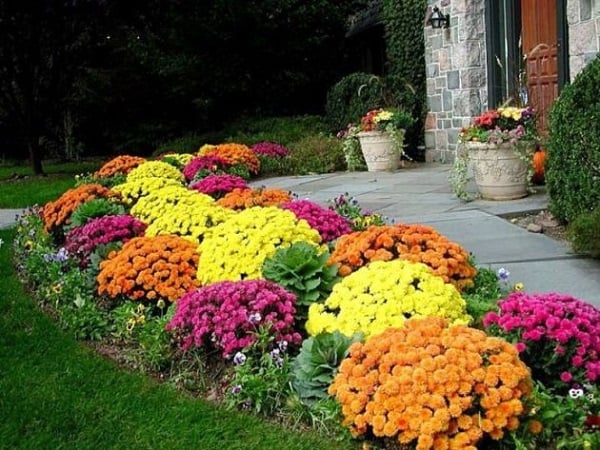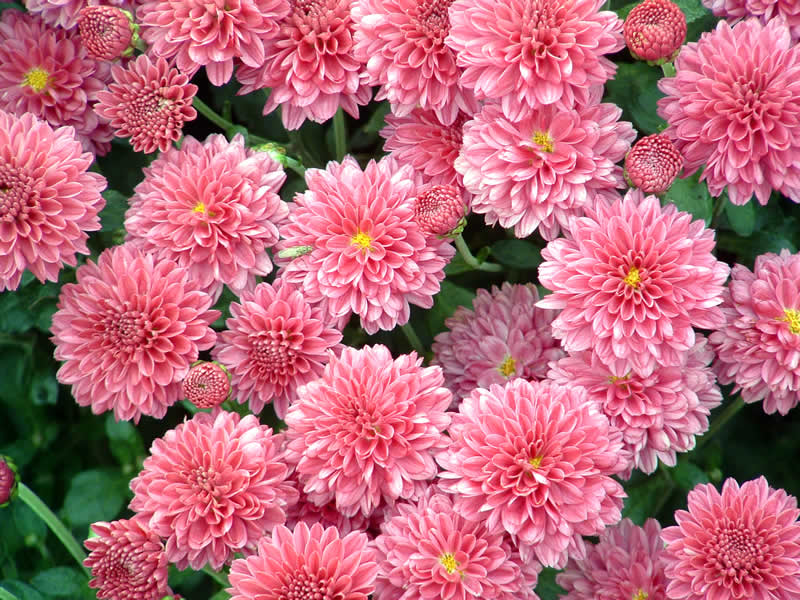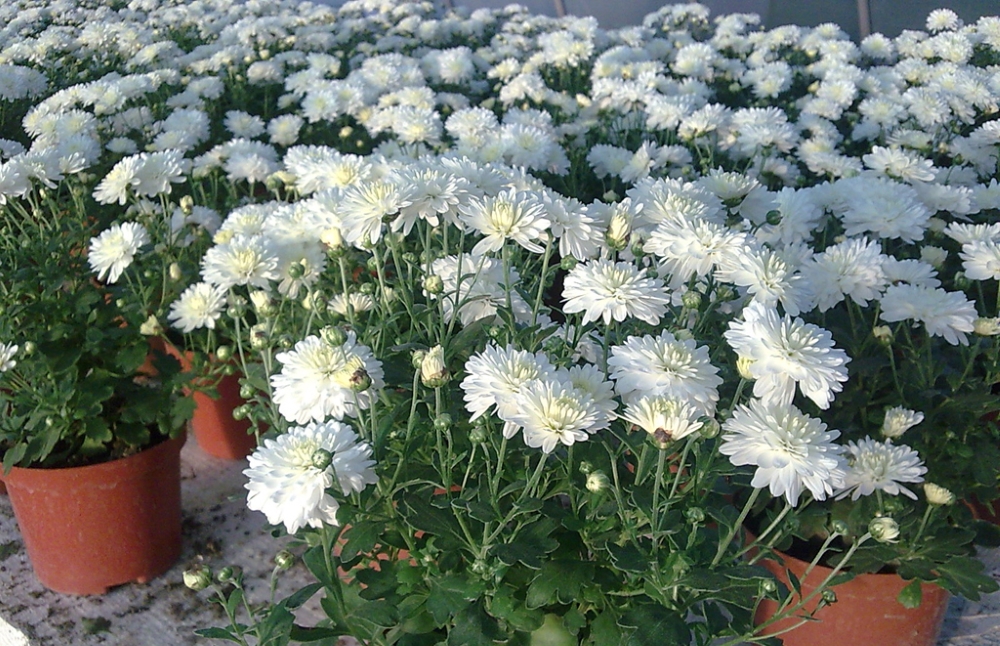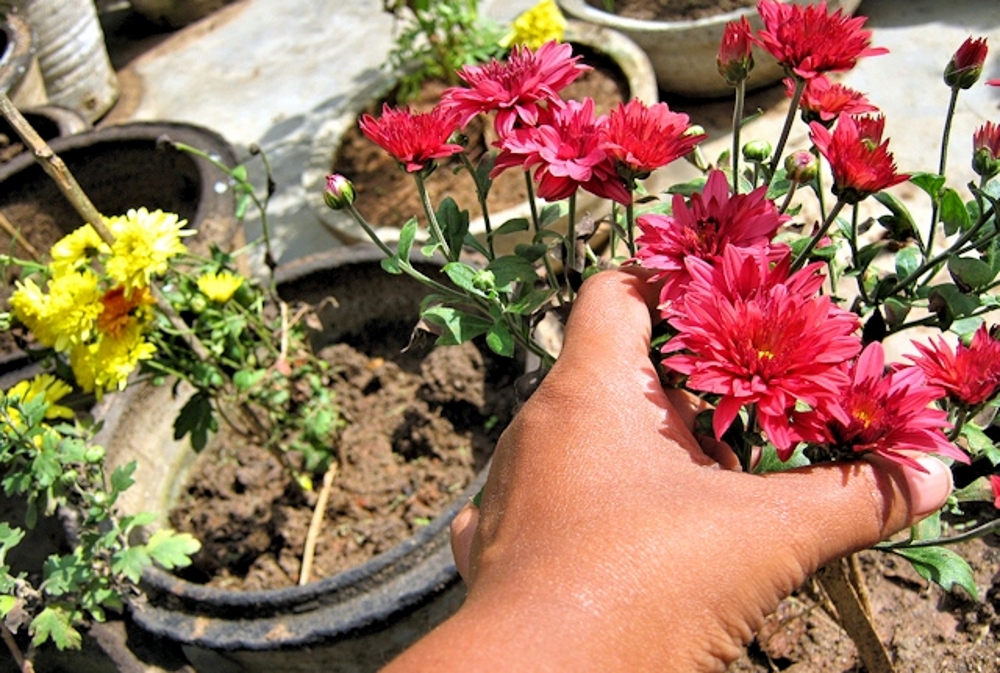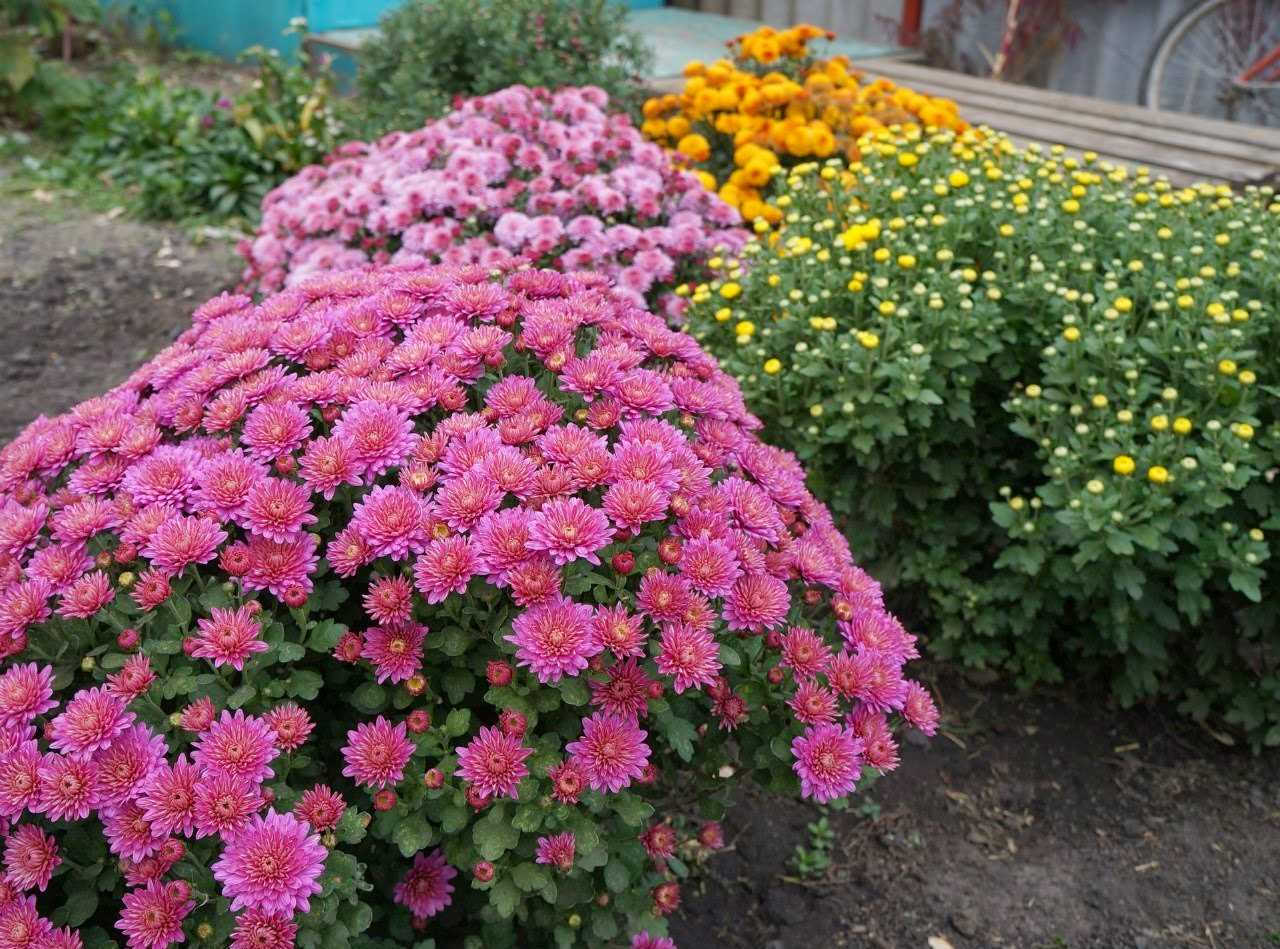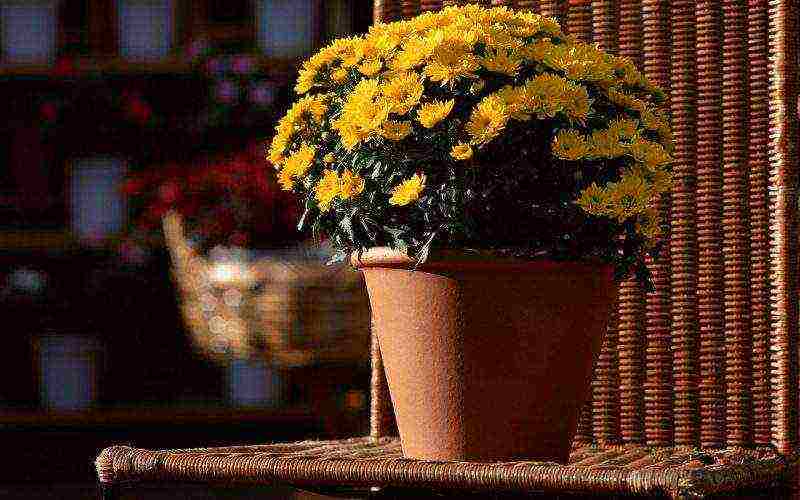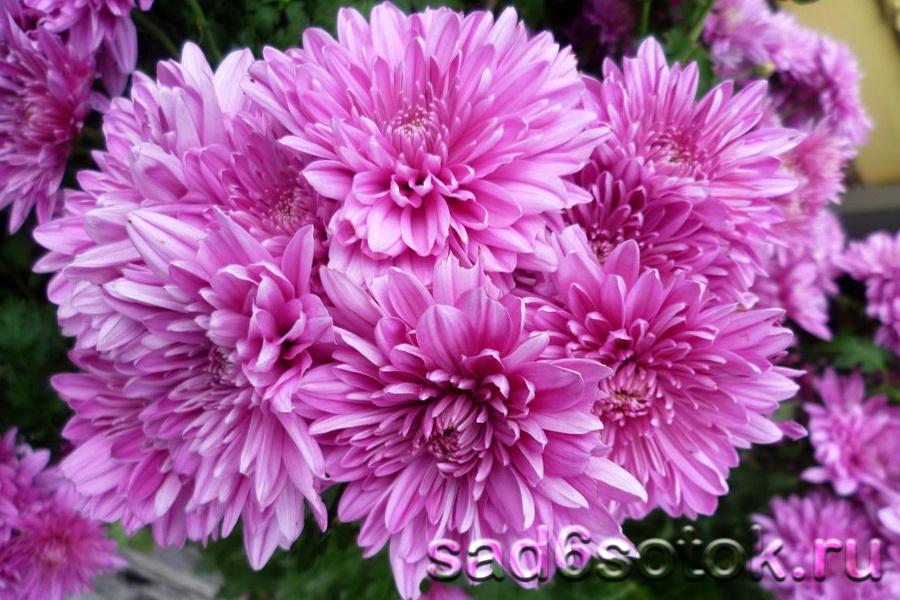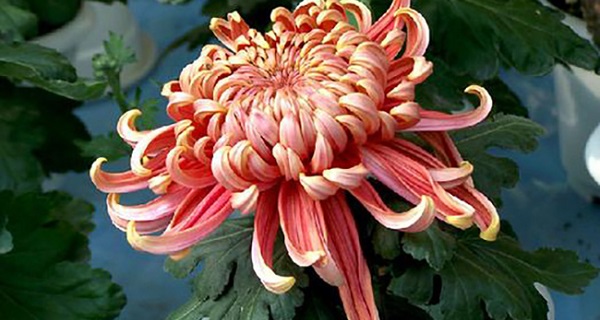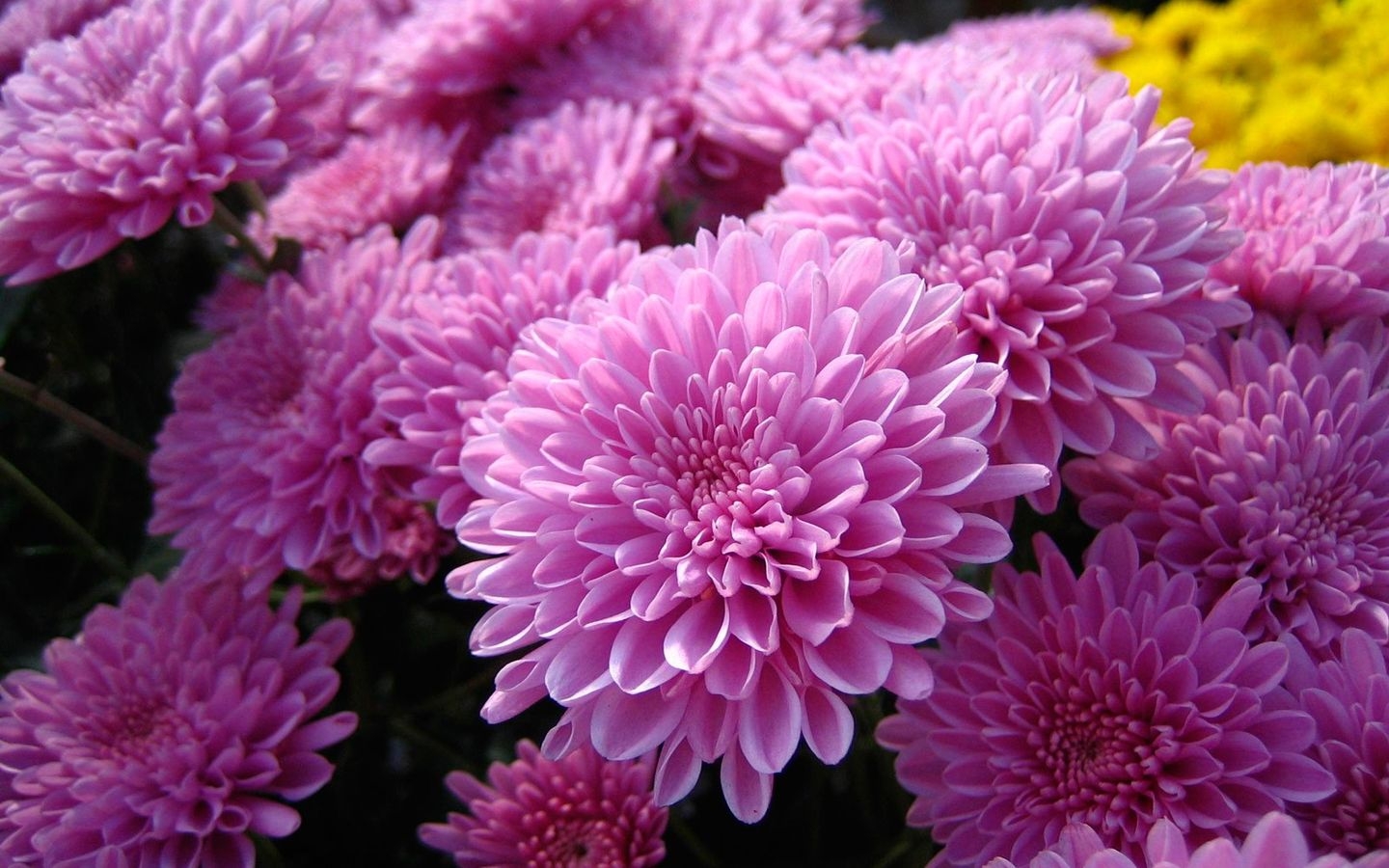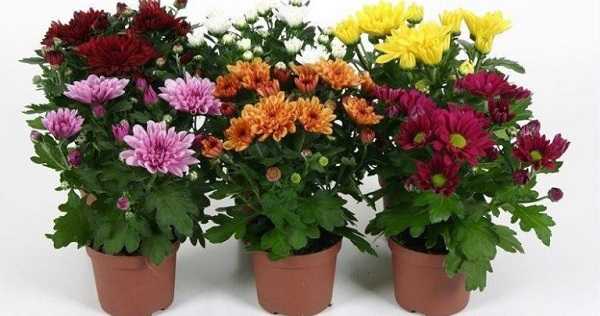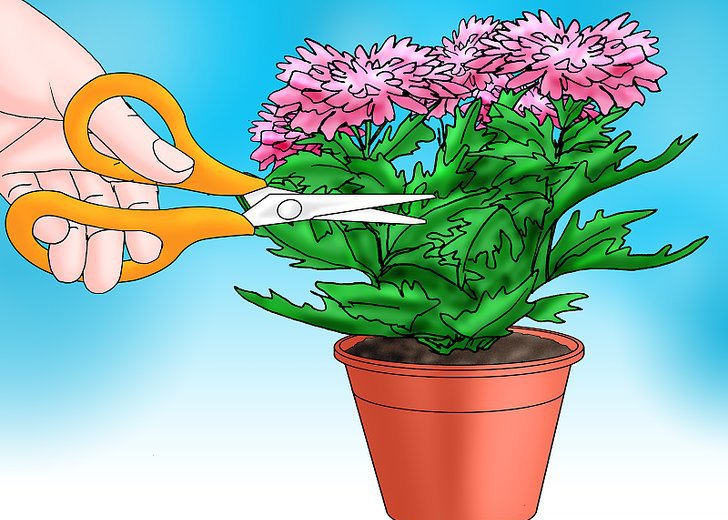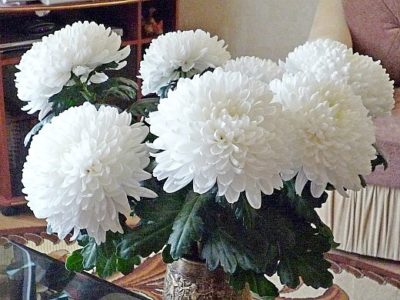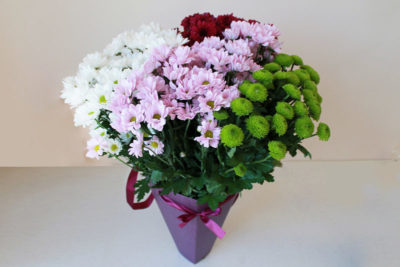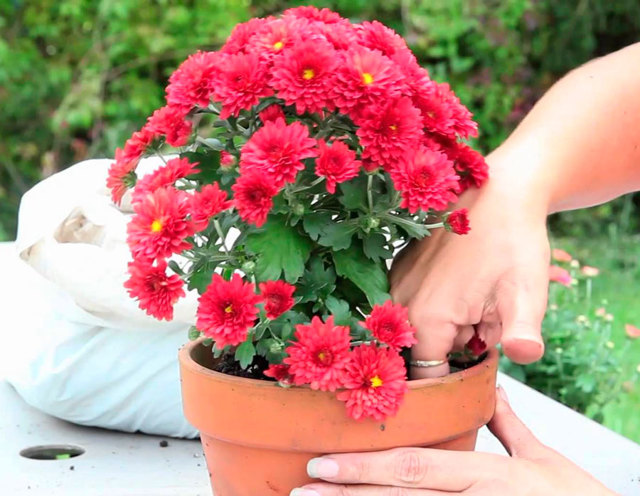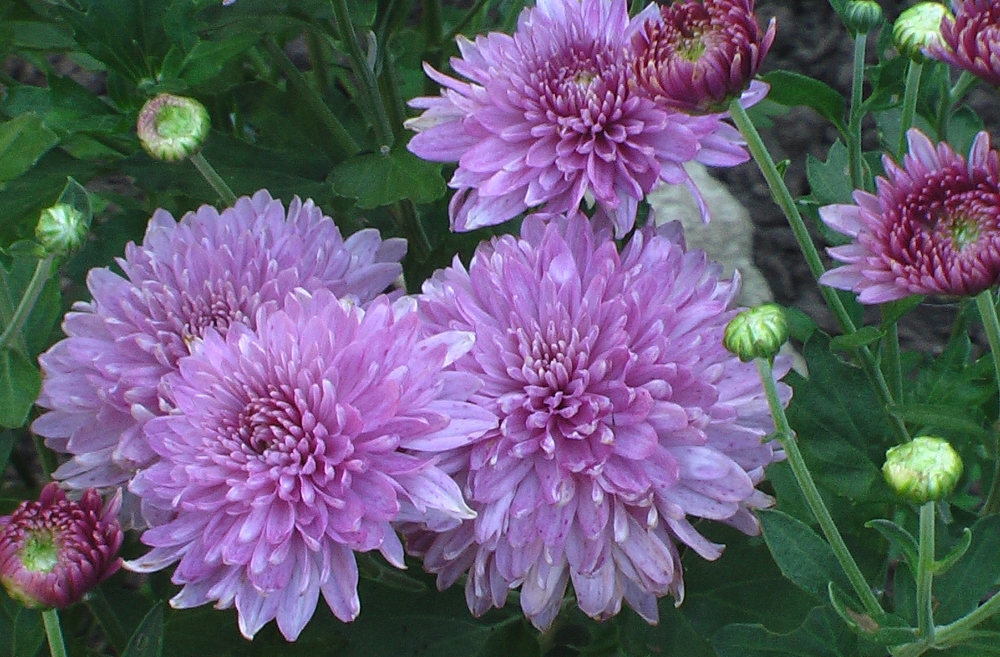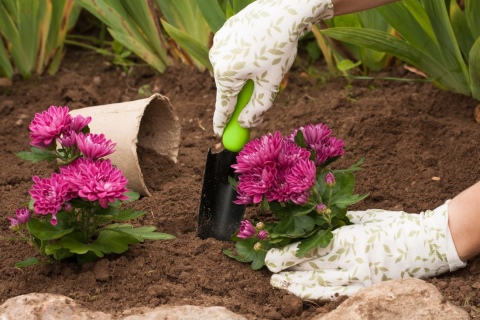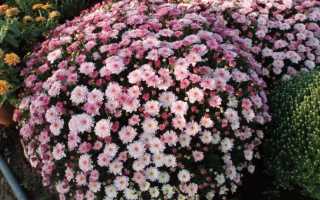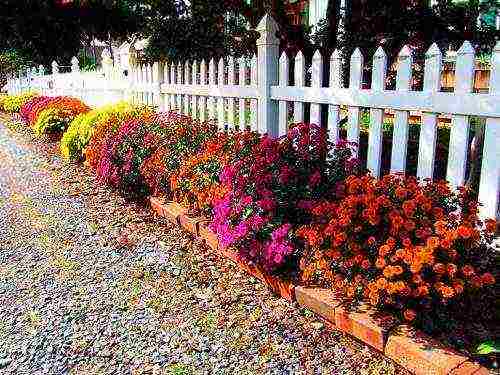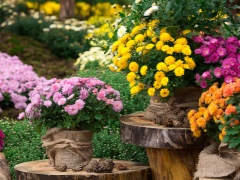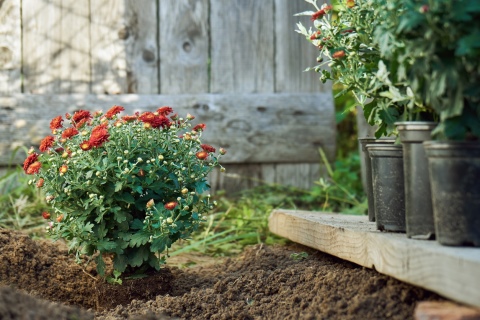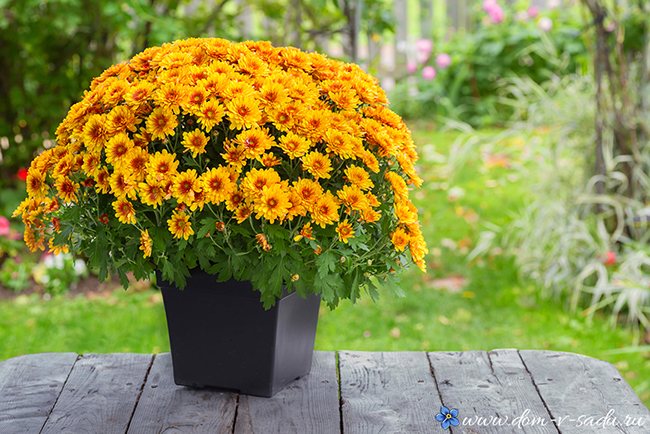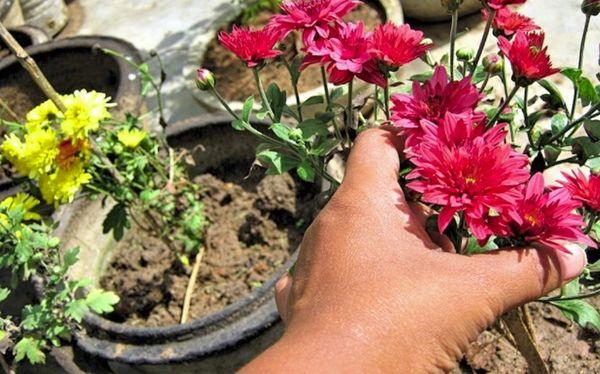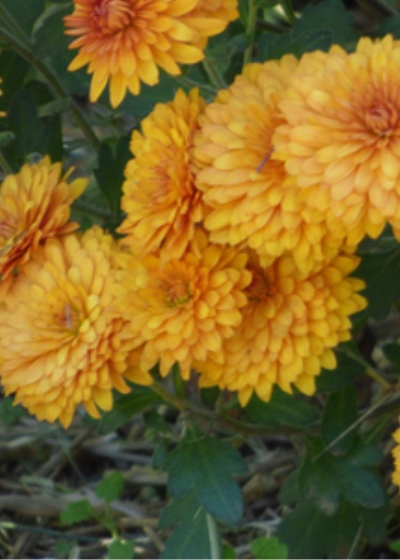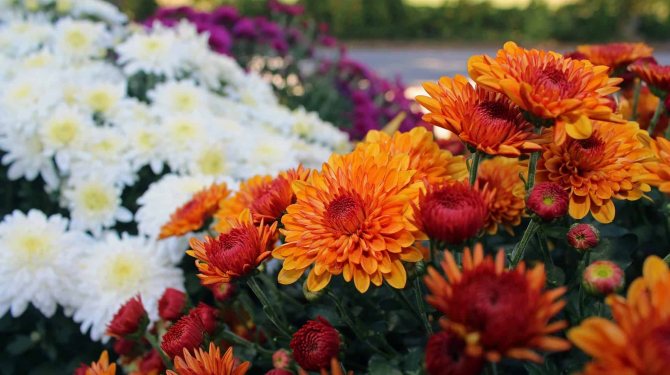Chrysanthemum transplant outdoors
Since chrysanthemums are perennial plants, they are able to withstand a long period of cold weather even in the open field.
In this case, it is very important to move the flower to another place from time to time. Thanks to this, chrysanthemums will grow and develop normally, and the flower bed will retain an attractive appearance.
The transplant procedure is usually carried out immediately after the snow melts.
In order for the result to meet expectations, it is important to know how and when to transplant chrysanthemums correctly.
How to transplant chrysanthemum in spring
Since chrysanthemum is characterized by active growth, in the process of development and formation of a flower, the soil under it is greatly depleted, the amount of nutrients in it is sharply reduced. This situation will ultimately have a negative impact on the state of culture. Therefore, the plant must be periodically moved to another location.
When is it better to transplant chrysanthemums - in spring or autumn? Experienced gardeners recommend the first option, since transplanting chrysanthemums is stressful for them, and if you move flowers before the onset of cold weather, they will not get strong enough and risk not surviving the winter. The second reason: the spring transplant is a fairly simple event. In the spring, after the snow has melted, the soil is moist and soft - under such conditions, it is much easier to dig up a flower. In addition, the likelihood of damage to the root system is reduced, while removing the crop from hard, frozen soil in the fall is difficult and leads to root injury.
Transplanting must be done before the plant begins to wilt due to the impoverished soil. This must be done in advance, until the flower withers away. At first, when the age of the flower does not exceed 2-3 years, the transplant is carried out once a year. Further, the procedure is carried out every 6 months.
The exact time of the work depends on the climate, but in any case, the plant can be “relocated” only at the moment of warm weather.
Note! It is recommended to replant the culture on cloudy days. The transplant process includes the following sequence of actions:
The transplant process includes the following algorithm of actions:
- Choosing a landing site. Beds exposed to sunlight are best suited for this. Groundwater should not pass too high, otherwise a little sand should be added to the holes.
- Flower preparation. Before removing the culture, it is recommended to moisten the ground, then it will be much easier to dig up the chrysanthemum and the roots will remain intact. Before transplanting, the bush is divided into several parts, cutting in such a way that roots with shoots are present on each part.
- Transfer. In advance, you need to prepare holes, the depth of which would be 18-22 cm, and the distance between them was at least 50 cm. Having placed flowers there, chrysanthemums are sprinkled with earth.
- Watering. For the first 2-3 weeks, the soil in the new place is thoroughly and regularly moistened, preventing stagnation of the liquid.
- Top dressing. Fertilizers can be applied 2-3 days after transplanting. As such, nitrogen and phosphorus compositions are used.
It should be borne in mind that only winter-hardy plant varieties are allowed to transplant in this way. Chrysanthemums dug out before the onset of cold weather and planted in pots, which were in the basements in winter, must be prepared in advance.
Autumn transplant
Chrysanthemum is a rather delicate plant and, despite its winter hardiness, it is still sensitive to cold weather.
In order not to cause harm when transplanting chrysanthemums to another place in the fall, it is important to follow all the necessary recommendations
- Before you "relocate" the chrysanthemum, you need to choose a good place for it. As such, a sunny plot of land with deep groundwater is suitable.
- The soil in the new location should not be too acidic.
- Hard and heavy soil should be fertilized with manure, peat or compost.
- The roots around the bush are pruned with a shovel, due to which there will be a rapid growth of roots, which will easily take root in another area.
- Before removing the chrysanthemum, the flower in the old place is watered with plenty of water. Then the culture is moved along with the excavated piece of soil.
- After transplanting, fertilizers are applied to the soil.
- 2 weeks after transplanting, the soil is filled up (the old one by this time will noticeably sag due to watering).
- The soil in the hole does not need to be pressed down strongly, otherwise the roots may be damaged and the plant will not take root.
Planting chrysanthemums in a pot
When preparing the land, it is important not to overdo it with feeding. An excessive amount of fertilizer will negatively affect the state of the flower: as a result of too active growth, the culture will quickly fade and wither before the onset of winter
The whole procedure is carried out before the onset of cold weather.
Are chrysanthemums dug up for the winter
Newbie gardeners sometimes wonder whether it is necessary to dig up chrysanthemums for the winter. There is no definite answer, since each variety has its own requirements. Some of them can safely winter on the street, others need to be transplanted into a pot and taken indoors for the winter. In any case, the chrysanthemum needs some points of care regardless of where it spends the winter:
Pruning. You need to let it bloom and cut off the stems, leaving only 10 cm.

Chrysanthemum pruning
Top dressing. At the beginning of autumn, it is recommended to start preparing and switch to phosphorus-potassium fertilizers. They will help the flower to survive the cold.
As a rule, the Korean (or Chinese) hybrid street chrysanthemum is the species that is most often found in Russia, it is winter hardy. This means that it does not need to be transplanted. Other species (for example, Chrysanthemum Mix - indoor autumn perennial) may need it.
Transplant and reproduction
 A little effort, and a beautiful chrysanthemum will appear in the house.
A little effort, and a beautiful chrysanthemum will appear in the house.
When the root of a young shoot no longer fits in the pot, the plant must be transplanted. For an adult chrysanthemum, the soil mixture is prepared from the following components:
- handfuls of bone meal;
- 3 parts of garden soil;
- 1 part sand;
- 0.5 parts of dry manure;
- 1 part peat.
The process has the following features:
- Transplant the plant into a larger pot.
- As with grafting, drainage is used.
- The day before the proposed transplant, the land is watered.
- A young flower needs support. When the stems get stronger, you can refuse it.
- If after a certain time roots appear on the surface of the soil, the chrysanthemum should be transplanted again. Otherwise, this procedure is not necessary. Although some breeders advise replanting a young crop annually, and adult flowers after 2-3 years.
Chrysanthemum is propagated in three ways:
- using seeds;
- cuttings;
- dividing the bush.
If you prefer to propagate a flower by planting seeds, you need to do the following:
- Fill the prepared container with drainage, then with soil mixture.
- Place the seeds to a depth of 1 cm. The chrysanthemum planting material is left on the surface.
- After two weeks, sprouts will appear.
- The soil must be constantly kept moist. The temperature should be up to 18 ° C.
- When several leaves appear, the culture is planted in separate pots.
To propagate the plant by dividing the bush, you need to remove the chrysanthemum from the soil in the spring and cut the root in half. Separate parts are planted in the soil with an interval of 35x35 cm. The composition of the soil mixture should include sand, humus and turf soil (in equal proportions).
Cutting method.A distinctive feature of this breeding method is that the procedure must be carried out in warm weather, when the temperature rises to 22 ° C-26 ° C. The process has the following features:
- Initially, you need to make the lower cut under the internode, and the upper cut 3 mm above the leaf with the bud.
- Prepare seedling containers. Nutrient soil is poured into them (composition: sod land, river sand, peat in equal proportions). You can add a handful of bone meal or dry manure. Sand is poured on top, in a layer of 2 cm.
- Select stems 15-20 cm high and cut off the tops of the shoots that grow from their base. Remove the bottom leaves.
- Dip the cutting into a special growth stimulant powder. They are sold in garden stores.
- Stick the cuttings into a damp spotting box so that a slight slope forms. Expect them to take root.
When can you transplant
Many gardeners believe that it is best to replant chrysanthemums in early spring, since at this time there is a sufficient amount of moisture in the soil, which contributes to the rapid rooting of the plant in a new place. Growing a plant involves the following types of transplants:
- planting seedlings in open ground;
- transplanting a plant from a pot to open ground;
- transplanting winter-hardy chrysanthemums from one place to another;
- transplant of non-frost-resistant chrysanthemum.
Chrysanthemum tolerates transplanting well, therefore, in some cases, you can do this in the summer.
The easiest way to reproduce chrysanthemums is by seeds, they are sown at the end of February in boxes with soil, which includes turf, peat and sand in a ratio of 1: 2: 1. Boxes are removed in a semi-dark place before germination, control soil moisture. After the shoots form 2 true leaves, they are dived, the cups with seedlings are placed in a place where the sun is not more than 5 hours a day. Seedlings are planted in open ground at the end of May, when the threat of night frosts has passed.
The time for planting in open ground planting material purchased in a store in a pot depends on when it was purchased. If a chrysanthemum was bought in the fall, after September 15, there is a possibility that it will not have time to take root before frost and will simply die. In this case, the stems of the plant are cut off, leaving no more than 10 centimeters in height, and stored until spring in the basement or heated garage.
Winter-hardy perennial chrysanthemum (Korean small-flowered chrysanthemum is considered the most popular) can be left to grow in one place for 3-4 years. Since chrysanthemum grows rapidly, its root system within a short period of time forms many small shoots, forced to feed from the main root, which leads to a rapid depletion of the soil at the location of the bush.
The weakening of a plant from a lack of nutrients can be determined by the flowers: they begin to shrink and lose their shape. This means that the chrysanthemum needs to be transplanted to another place with a more fertile soil composition. It is better to replant perennial plants in the fall, 20 days before the onset of permanent frosts, so that the stems have time to take root. A chrysanthemum transplanted in autumn will bloom earlier the next year than transplanted in spring.
A non-frost-resistant perennial plant is best transplanted in the spring, this will help preserve a rare flower. Compared to the autumn transplant, the spring transplant delays the beginning of flowering of the plant, but this deficiency is easily compensated for by early flowering annuals.
You can transplant chrysanthemums at home into a larger pot at any time of the year.
Subject to certain rules, you can transplant a flowering plant.
Flower transplant
The procedure itself is not complicated and will take very little time. The only thing with which difficulties may arise is the rhizome. He needs to inflict minimum damage.
How to transplant indoor chrysanthemum correctly:
- Water the soil in the pot and give the soil time to fully saturate. This will make it easier to extract the plant.
- If the container is plastic, you can squeeze the sides slightly to release the earthen ball and create a gap. You will have to work hard with a ceramic product. You will need a flat tool that is carried along the edge, to the full depth, for the same purpose - to separate the substrate from the container.
- Carefully remove the plant along with the soil.
- With a highly developed root system, you need to try, without damaging the antennae, to remove as much soil as possible. With young animals, there will be no such problem, they have a poorly developed underground part.
- Pour freshly prepared substrate onto the drainage layer laid out in a new pot.
- Plant the chrysanthemum, fill up the missing amount of earth and tamp it slightly. Add more filler as needed.
- It is good to water the plant with settled soft water at room temperature.
Now the pot with the transplanted flower can be put back to its former “place of residence”.
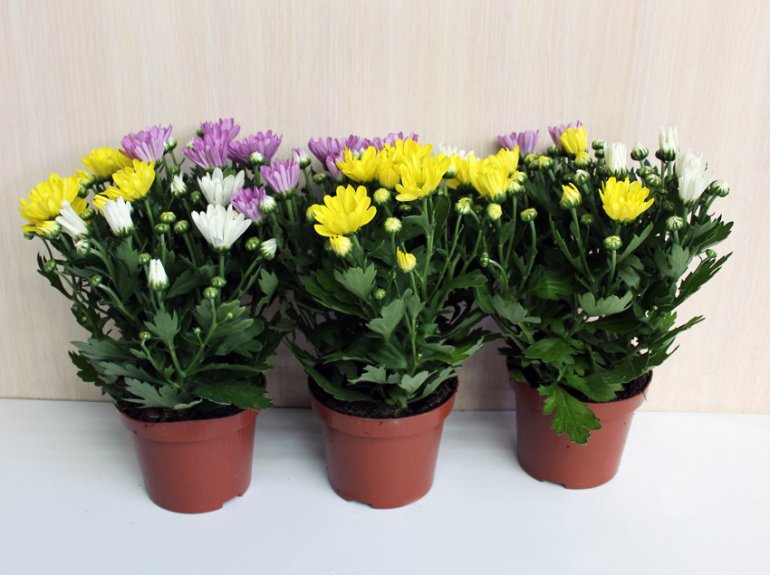
Chrysanthemum diseases
For many years of existence on the planet, chrysanthemums have developed immunity to various diseases and insect pests. But there are diseases in front of which the chrysanthemum is weak.
For example, gray rot. It can be identified by the presence of light brown spots on flower buds and petals. This disease is provoked by increased soil moisture. As soon as spots appear on the plant, it is necessary to reduce watering to a minimum, remove the affected inflorescences. If the gray rot has spread to the entire bush, it is recommended to dig it up and burn it.
A white bloom on the stem and leaves of the chrysanthemum indicates that it was attacked by powdery mildew. To avoid the spread of this disease to other bushes, the plant should be treated with any of the drugs:
- topaz;
- champion;
- copper sulfate.

Powdery mildew on a plant is the scourge of all flower growers
Root cancer cannot be cured. The disease identifies itself by the appearance of spurs near the root on the stem. Such a bush must be dug up and burned, and no crops should be planted in its place for some time. Treat the soil with formalin.
Among insects, attacks of aphids, thrips, May beetle, bedbugs are not uncommon. But these pests are successfully combated by insecticides.
When to plant chrysanthemums from a pot. Where and how to plant flowers
In order for the chrysanthemum to winter well, it is determined only in a sunny place where moisture does not stagnate. Soaking roots is one of the reasons for the death of a plant. Many gardeners notice: where there are spring waters in the garden, not a single chrysanthemum survives. Therefore, landing on small hills or slides is allowed.
Flowerbeds or rockeries with chrysanthemums enliven the garden in autumn
The queen of autumn loves neutral and slightly acidic fertile soils. It is advisable to dig up poor soil before planting with the addition of 2 kg of mature humus or compost and 1 tbsp. l. superphosphate per 1 m2. If there is no rotted organic matter, add 1-2 tbsp to the ground. l. nitroammofoski per 1 m2. If necessary, heavy soils are lightened with sand.
Fertilizer superphosphate is necessary for the abundant flowering of chrysanthemums
Chrysanthemums are best planted in the evening or in cloudy weather. For the roots to develop freely, a sufficient distance between plants is required: 30-50 cm, depending on the size of the bush.
Step-by-step instructions for planting chrysanthemums:
- Before planting, soak the roots of the plant for 1 hour in a solution of humates, Kornevin or another rooting agent according to the instructions.
- Dig a hole 35–40 cm deep.
- To improve the drainage properties of the soil, pour three handfuls of coarse sand to the bottom and mix with the earth.
- Place the bush in the hole and spread the roots evenly out to the sides.
- Sprinkle the plant to the first leaves with a mixture of soil and old humus, if the area has not previously been fertilized.
- Pack the soil around the seedling and water liberally.
- Sprinkle a thin layer of compost, old manure or peat on the tree trunk.
- Without mercy, trim the flowering stems above the bud to leave 5cm stumps.
Shade the bushes with agrofibre for quick rooting in hot weather. Water them only at the root as the soil dries out.
Kornevin - a stimulator of the formation of the root system of plants
Korean chrysanthemums live longer when transplanted annually.
Chrysanthemum features
Chrysanthemums are represented by perennial or annual dwarf shrubs and herbaceous plants. The branched rhizome grows parallel to the soil surface. The stems may have pubescence on the surface, but they may also be glabrous. Simple alternate naked or pubescent leaf plates differ in size and shape: serrated, notched or dissected. As a rule, foliage is colored greenish, but it can also be dark green. Most often, small flowers are part of the inflorescence-basket, which in some cases can be quite large. The basket consists of single-row lingual marginal and median tubular flowers, but in most hybrid varieties they are arranged in multiple rows, as a result of forming a lush inflorescence, which is called terry chrysanthemum. The fruit is an achene. Today, gardeners cultivate varieties and types of the so-called mulberry or garden chrysanthemum. It is also sometimes referred to as chrysanthemum chrysanthemum. This group of varieties and hybrids is very complex, and they also have a confusing history.
Chrysanthemums. Features, care and reproduction
The nuances of the procedure
Transplanting a plant to another place in the autumn is very beneficial in terms of the development and strengthening of the root system. Strong frost resistance develops, which will have an excellent effect on the winter quarters. The best period for transplanting a plant begins after a stable warm temperature regime has been established. In the spring, it is great to plant home-grown chrysanthemums, varieties that bloom in summer.
To transplant chrysanthemums into open ground, it is necessary to choose the right variety depending on the climatic conditions of the region. To date, many varieties have been bred that can withstand even the coldest winters and do not require additional maintenance or digging. Chrysanthemums should be transplanted in autumn carefully in accordance with the rules, then the plant will delight with its flowering for many years.
During flowering
The most favorable time when the chrysanthemum is to be transplanted is from September 15 to October 10. Rainy weather during this period will promote better rooting and adaptation in the open field.
Chrysanthemum is more vulnerable during flowering, so you should refrain from transplanting a flowering plant in October. The most favorable time for replanting chrysanthemums is the beginning of September, then the flowering plant will have time to take root before frost.
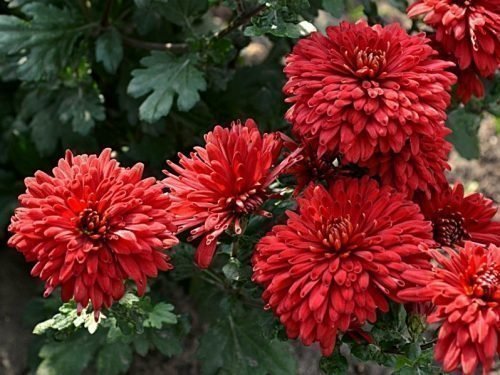
You can transplant a blooming chrysanthemum in the fall using the following algorithm:
- prepare a site for a transplant, for which you must first dig a trench of arbitrary length, 50 cm deep;
- the bottom must be drained with river sand, which will improve the outflow of excess moisture;
- prepare an earthen substrate from the upper fertile layer of soil and peat;
- place the plants one at a time in the trench, spaced between them;
- pour water at room temperature.
Pot transfer
In order to properly transplant a chrysanthemum in open ground conditions, it is necessary to take into account many factors, especially pay attention to the places for planting
- The place for the transfer should be well lit.
- Avoid lowlands that can be flooded, places with a high groundwater table.
- Autumn planting requires a careful check of the weather conditions for the next 2 weeks, if a newly transplanted plant is exposed to frost, it will be lost.
- The soil for planting should contain a neutral or slightly acidic pH.
- You can not place flower beds in a shaded area, otherwise there will be no flowering.
- For transplanting in the spring, you need to choose early varieties, and in the fall - late ones.
Chrysanthemum transplantation in autumn, as well as in spring, should be carried out in pre-prepared places. Plants cannot be planted immediately after purchase, if we are talking about the spring thaw, it is necessary to give them time to adapt to outdoor conditions, especially if the chrysanthemum was stored indoors.
Drainage from stones or broken brick is placed in the dug grooves, 50 cm deep. Next, soil is added, mixed with humus, peat and sand in proportions of 1: 1. The earth is left for several days so that it is enriched with minerals, and then chrysanthemum is transplanted.
The purchased seedlings in a pot must be carefully removed. For this, the plant is poured with water, softening the earthen lump. The rhizome should be washed, removing soil residues.
Next, place the flower in the hole and sprinkle it with soil, trying to fill in all the voids formed when filling the earth. Tamp the top layer of soil a little and water it with warm water.
An interval of 20-30 cm should be observed between the plants so that the flowers do not interfere with each other's growth. Blooming chrysanthemum can be planted at a distance of 40 cm, depending on the size of the bush.
What to look for when buying a potted chrysanthemum?
When choosing a chrysanthemum, make sure that the plant has a lignified lower part of the stems. Lethargic, grayish or yellow leaves indicate that the chrysanthemum is weak and will not be able to winter even in comfortable conditions.
It happens that the leaves look healthy, but if you carefully examine the underside of the leaf, you can see a thin web. This means that a spider mite attacked the plant.
It is better to provide that the chrysanthemum that you purchase has as few flowers as possible that have already opened. It is ideal if only the details of the opening petals are peeking out from the practically corked bud.
The autumn cold is not terrible for potted plants, however, during the initial frost, they can be severely damaged. Do not buy frozen chrysanthemums at low prices. Their flowers may look quite healthy, but the edges of the leaves "hang down", their leaves become dark in color, and after a few days they can dry out completely.
Vendors will reassure that chrysanthemum conditions are beneficial. Remember that frozen plants will not be able to survive the winter period, you can purchase them exclusively as a bunch at a time.
Preparing for landing
If you decide to plant a lovely chrysanthemum in a pot, you will need to take into account a number of key features so that the flower grows safely in the apartment. Let's consider each aspect in more detail.
Seat selection
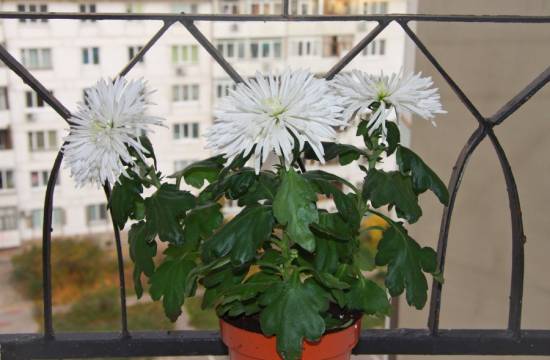 Chrysanthemum loves a shaded and warm place
Chrysanthemum loves a shaded and warm place
You need to choose a suitable place for a flower taking into account the following factors:
- In order for a chrysanthemum to feel comfortable, it must be in certain temperature conditions. The best place for her would be a window sill on the east or west side of the house.
- You can not place the plant in the northern direction, since this will adversely affect its development. The chrysanthemum may not even bloom.
- In the summer, the temperature in the room where the flower culture grows should be between 20 ° C-24 ° C.
- With the onset of autumn, their level should be lowered to 15 ° C-18 ° C. You should not exceed the temperature.
- You should also take care of the lighting. Flowering depends on this. Chrysanthemum prefers short daylight hours, prolonged exposure to ultraviolet radiation is extremely undesirable for it. It is enough for the plant to receive the sun's rays for eight hours, after which the culture should be covered with a paper cap.
Soil preparation
The soil for the chrysanthemum should be loose, neutral and rich in nutrients. To prepare you will need:
- sand;
- humus;
- sod land.
All components are mixed in equal proportions until a homogeneous mass is formed. Bird droppings can be added to increase the nutrient content of the soil mix.
Garden chrysanthemum care
How to care for a chrysanthemum?
- Planting and caring for a chrysanthemum is not particularly difficult, but certain rules must be followed. For example, seedlings that are planted in open ground, when they get stronger and release the eighth leaf, must be pinched to strengthen the branches to be demolished. For the same purposes, young lateral shoots, which appear soon, are also pinched. Thanks to these actions, you can get a nice and dense bush that will look attractive and spherical during flowering. It is worth noting that this rule does not apply to large-flowered chrysanthemum, since it is recommended to completely remove the lateral shoots from it, leaving only a few of the strongest. At the same time, the removed shoots take root easily. Some tall plant varieties need to be maintained, for this it is recommended to use various metal supports in the form of pegs, nets or wire structures that are able to hold and prevent it from falling apart.
- If we talk about moisture, then each watering of flowers should be abundant. Insufficient watering can cause lignification of the stems. The flowers will be less attractive. It is recommended to use rainwater or settled water for irrigation. You can also add a few drops of ammonia to the water. When watering, it is necessary to avoid getting water on the leaves; it is necessary to pour water at the very root. Watering should be accompanied by loosening the soil around the bush, removing weeds, unless you have mulched the soil after planting.
- Chrysanthemum care also implies mandatory feeding. During the growing season, it is necessary to carry out at least 3 dressings. Top dressing must be alternated with mineral and organic fertilizers. At the beginning of the growth of chrysanthemums, it is recommended to feed with mineral fertilizers based on nitrogen. As a result, green mass is actively growing on the plants. To stimulate the intense flowering of chrysanthemums, it is necessary to feed with phosphorus-potassium supplements during the budding period. Plants are also fed with fertilizers in the form of solutions, which must be poured out to the very root the next day after rain or watering. The first feeding should be done in the first 6-8 weeks after planting. If we talk about organic fertilizers, then flowers prefer burned-out mullein or bird droppings. Despite this, the golden rule of flower growers is that it is better to under-feed the plants than to burn them.
How to transplant flowers?
in one place they cannot grow for more than 3 years; flower transplantation is carried out by dividing the bush
- To do this, you need to carefully dig out the bush, trying not to damage the root system;
- Shake off the soil from it;
- Use a sharp knife or pruning shears to divide the bush into small bushes with a root system.
- After that, the resulting bushes can be planted in a sunny area in the usual way.
Planting chrysanthemums in the spring by dividing the bush
Every florist knows when to plant chrysanthemums. The most convenient and easiest way to do this is in the spring, when the plants emerge from the period of physiological dormancy. You can also grow flowers from seed, but such sowing is long and troublesome. In addition, seeds purchased from the market are often of poor quality. Propagation by cuttings is more reliable. If the weather is unstable, it is better to wait until the last ten days of April - the first ten days of May.
Correct step-by-step instructions for breeding:
- Choose a healthy and strong uterine bush, not affected by pests and parasites, not suffering from fungus and normally developing;
- Dig up the plant;
- Using a sharpened knife, divide it into several parts. Each fragment should have its own root and young shoots;
- Layers are planted in pre-prepared pits filled with a complex mineral fertilizer and nutrient mixture.
Young shoots are watered abundantly. It is possible to plant chrysanthemums in this way in the fall, but in this case, young shoots need careful shelter for the winter. For this purpose, it is best to use oak branches or spruce branches.

The easiest and most popular breeding method is by dividing the bush.
It is known that at least 6 cuttings can be obtained from a normally developing bush 3 years old, most often 4-5 cuttings. The older the plant, the more side shoots it has. However, you should not choose the oldest bushes, because they are more likely to be infected with infections or parasites.
How to transplant a chrysanthemum
If you decide to plant these flowers, then you need to know how to transplant chrysanthemums and what soil to choose. Since these plants begin to bloom in the fall, it is better to transplant in the spring. The procedure can be carried out in the fall after flowering and pruning for the winter.
Transplanting chrysanthemums in spring allows a capricious plant to get used to a new pot over the summer. If the chrysanthemum is young, then it should be transplanted every year for about three years, and then it can be done once every two years.
The soil is of great importance for the chrysanthemum. You can buy it in a special store or prepare the same soil at home. To do this, you need to mix:
- two parts of turf soil;
- one part of sheet soil;
- one part of humus;
- one piece of sand.
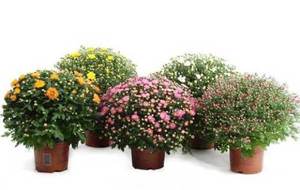 Stir the soil and heat it well in the oven, this method kills pests and fungi that can load the flower. And you can also add a little chicken droppings, the main thing is not to overdo it with the addition so that the earth does not become sour. Supplementing with chicken manure has a positive effect on the root system of the flower.
Stir the soil and heat it well in the oven, this method kills pests and fungi that can load the flower. And you can also add a little chicken droppings, the main thing is not to overdo it with the addition so that the earth does not become sour. Supplementing with chicken manure has a positive effect on the root system of the flower.
Take a pot with a larger diameter than it was, lay out the bottom with pebbles or expanded clay. This must be done so that there is a drainage layer.
You need to transplant a flower very carefully and carefully. Carefully remove the plant from the old pot, shake off unnecessary soil
All actions are performed carefully so as not to damage the root system. After that, place the flower in a new pot, carefully fill in the soil prepared in advance. Lightly tamp the soil, and then spill well.
Chrysanthemum transplant in autumn
You need to carefully transplant flowering chrysanthemums. The slightest damage to the roots is destructive for her. To begin with, I prepare a spacious pot, and I arrange drainage from pebbles at the bottom. The soil will do the most common, from the garden, if it is not too acidic.
Fresh articles about garden and vegetable garden
Winter garlic turns yellow: what to do?
Yeast as a plant fertilizer: how to prepare it?
Soaking seeds in vodka: benefit or harm?
Before digging, I spill the bush well with water. You need to dig up a flower with a large clod of earth, you need to take into account that the roots go quite deep. I put the flower in a pot for drainage, then I fill the voids with soil. Then the soil will settle a little, it will need to be poured.
For the first time I put the pot with a flower in a cool, dark place. For about a week he stands on the veranda. Then I bring it home, but I also choose a cooler place.
When the chrysanthemum has faded, I cut off the stems, leaving 15 centimeters, the same as when cutting chrysanthemums, which I wrote about here. I water and put a paper bag on top of the pot. In this form, I lower it into the cellar for winter storage. The flower needs peace at this time. So, at a temperature of +3 degrees, it is perfectly stored. Sometimes I check it and water it a little every 2 weeks so that the roots do not dry out.
With the onset of spring, you can remove the bag from the pot so that sprouts begin to appear. When the spring frost has passed, the plant can be planted back into the ground.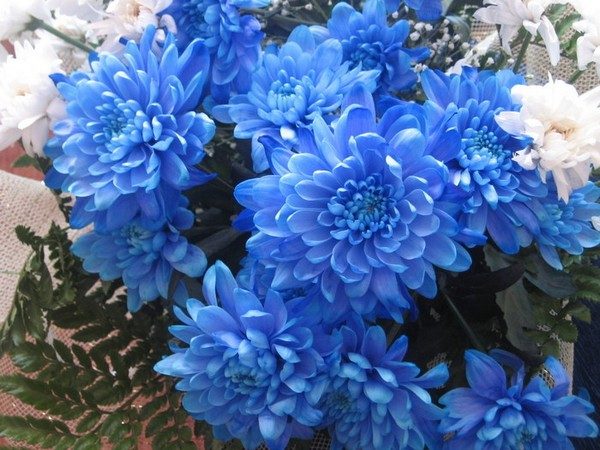
How to plant a bouquet of chrysanthemums in a pot
Growing a chrysanthemum in a pot is easy enough. Planting material can be taken from a healthy shrub in the garden. Or use a decorative flower from a donated bouquet.
Conventional transplant
Transplanting a chrysanthemum from the garden is as follows:
1. Initially, you need to choose a healthy shrub that has not been exposed to pests or diseases.
2. At the end of autumn, the bushes are dug up and transplanted into pots
It is important not to damage the root system.
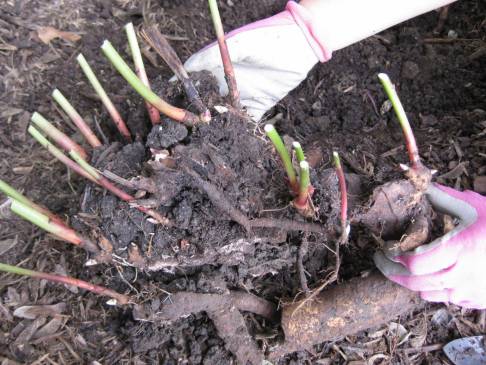 We dig out the root and transplant it into a pot
We dig out the root and transplant it into a pot
3. After flowering, pruning is carried out and the flower is placed in a place with a temperature not exceeding +6 C. In such conditions, the chrysanthemum should spend the whole winter.
4. Cuttings are carried out in early spring. To do this, they are planted in perlite or vermiculite to a depth of 2 cm.
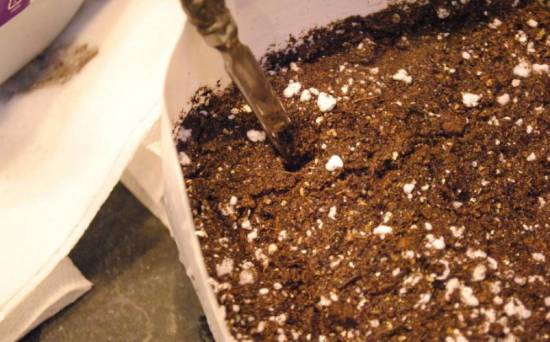 Transplanting cuttings
Transplanting cuttings
5. Then the cuttings are placed in a small greenhouse. If this is not possible, you can use a film. Under it, you need to carry out regular spraying of plants, as well as maintain an air temperature of about + 21 ° C.
From a bouquet
In order to transplant a flower from a bouquet, you need to do the following:
1. The first step is to prepare the cuttings. With chrysanthemums, you need to remove the leaves and inflorescences, pinch the tops.
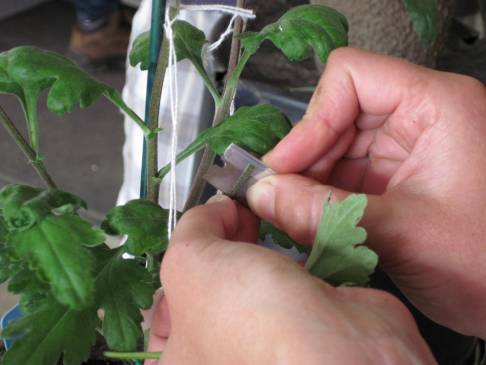 Harvesting cuttings
Harvesting cuttings
2. Then the plant is placed in a container with water, where the cutting should be until the root system is formed.
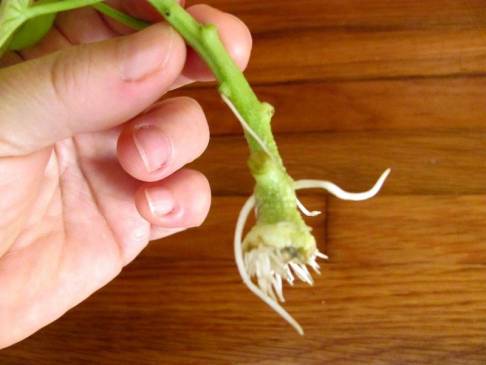 We are waiting for the appearance of roots
We are waiting for the appearance of roots
3. For planting, you need a pot with a diameter of at least 30 cm. The bottom of the container must have holes to drain excess moisture. A drainage layer is first poured into the pot. This will help prevent root rot. To do this, use small expanded clay or brick chips.
4. Then a nutritious soil mixture (turf, peat and sand), which has neutral or slightly acidic properties, is poured. It is recommended to add mineral fertilizers to the soil. Before planting, the substrate is also watered abundantly with water.
5. Then the cuttings are placed in the soil. A distance of 30 cm should be observed between them. The tops are periodically pinched so that the new buds acquire a spherical shape.
Where and how to plant chrysanthemums in autumn
In order for the autumn planting activities not to end in fiasco (plant death), it is necessary to adhere to several important rules.
Dates of autumn planting
Planting work must be completed 20-30 days before the onset of stable frosts, this is the time the chrysanthemum will need for full and successful rooting. Otherwise, the plant will not have time to take root in a new place and will not withstand winter frosts. Specific dates depend on the characteristics of the local climate. In northern latitudes, planting is recommended to be completed no later than mid-September, while in the south this process can be extended until the end of October.
If it was not possible to plant a chrysanthemum seedling in open ground on time, then it is better not to risk it. The flower can be temporarily kept on a windowsill (in a pot) or placed in a basement (cellar).
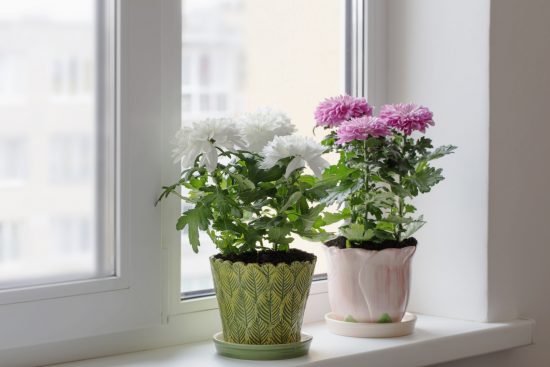
In order not to risk it, the chrysanthemum can be temporarily planted in a flower pot and kept at home until spring.
Site selection and site preparation
A flower bed for chrysanthemums is arranged in a slightly elevated, well-lit, sunny place, which is protected from sharp gusts of wind. Shady areas will not work, because there the plants are stretched and bloom poorly. This culture does not tolerate the close location of groundwater and stagnation of moisture, therefore, if necessary, drainage is made from river sand and gravel.
Chrysanthemum develops best on well-drained, loose sandy loam or loam with an acidity level as close to neutral as possible. Poor sandy soils are enriched with humus and clay (1-2 buckets per 1 m 2), sand is added to heavy clay soils for relief (2-3 buckets).
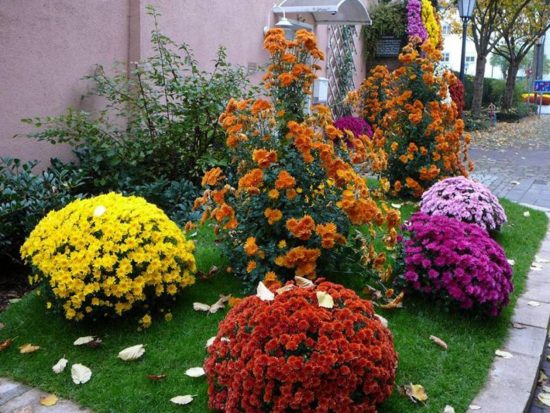
It is better to plant chrysanthemums in open, sunny and elevated places.
Step-by-step instruction
Planting work is carried out in cloudy weather, it is good if there is a little autumn rain.
The algorithm of actions is as follows:
- At a distance of 0.3-0.5 m from each other, holes are dug for planting (if there are several flowers) with a diameter of about 0.5 m and a depth of about 0.35-0.4 m.
- A drainage layer (3-4 cm) of small stones, pebbles, sand, etc. is poured onto the bottom.
- A nutritious soil mixture is prepared from the extracted soil by adding to it:
- humus or garden compost - 5–6 kg;
- peat - 3-4 kg;
- potassium sulfate - 7-10 g;
- superphosphate - 10-15 g.
- The seedling is lowered into the hole, placed in the center, carefully spreading the roots in different directions. The root collar should be at the level of the soil. Previously, all the shoots are shortened by a third, the peduncles are completely removed.
- The hole is filled to the top with soil mixture, slightly compacted with your hands.

The hole is covered, and the earth is compacted with hands
I always carefully cover chrysanthemums planted in late summer or early autumn for the winter with straw and branches, and then I also throw a snowdrift on top.

